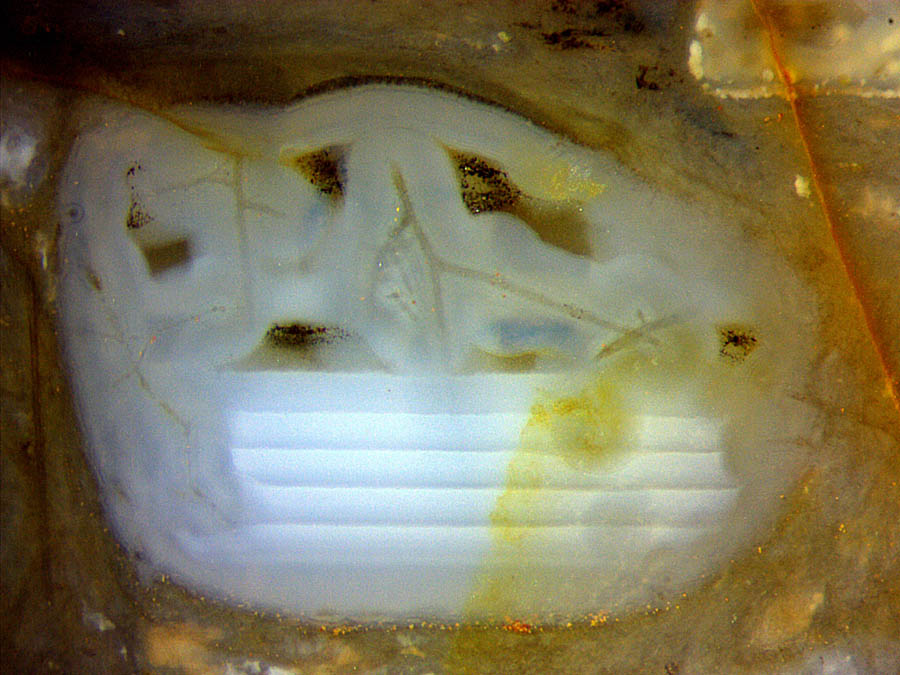Agate and fossil from watery habitat
(2)
--- Eerie glow
 As
discussed in Part (1), the combination of agate and fossil
may be surprising but is not really so, although
the aspect of the agate itself may be. The "banded"
structure usually seen in sections of former cavities is due to
silica deposition in layers, mostly at the cavity walls, often at
differential rates or with interruptions.
As
discussed in Part (1), the combination of agate and fossil
may be surprising but is not really so, although
the aspect of the agate itself may be. The "banded"
structure usually seen in sections of former cavities is due to
silica deposition in layers, mostly at the cavity walls, often at
differential rates or with interruptions.
The present sample is different, not only because of its eerie glow
under incident (!) light but rather because of the evenly stacked
horizontal layers.
Image:
Former gas bubble in swamp water, now filled with solid chalzedony of
various aspect, with branching fungus hyphae. Image width 2.8mm.
This agate began with a
swamp
gas bubble. After the surrounding silica-rich water had become silica
gel, thus
stabilizing the shape, diffusion
made the gas escape and silica
solution enter. Branching
hyphae of some aquatic fungus
grew there. Next, cavity walls and hyphae
got a thick
coating of silica gel.
This must have occurred in one process stage
since the coating is not
layered.
In the remaining water
pocket,
SiO2-clusters grew until they sank to the
bottom, forming a heavy liquid suspension
there, which separated
itself from water with a horizontal boundary.
Apparently this had been
going on repeatedly, governed by unknown means with surprising
accuracy, thus creating the wondrous
structure.
The
black debris
in the above compartments, possibly decayed microbes, must
have come later since no such is seen among the layers below.
Finally, the remaining water and everything else silicified
into
chalzedony.
The
yellow-green streak below marks a crack slightly inclined to the
cut face, with a gap narrower than the light wavelength since
it does not reflect the
incident light, and with traces of some staining mineral. For comparison, see the wider crack above right, which makes a shadow.
The conspicuous apparent glow is brought about by reflection
of the incident light at silica grains once formed in the water but now
fused into solid chalzedony.
Sample:
Rh13/14.1 (2012)
H.-J.
Weiss 2019
 |
 |
143 |


 As
discussed in Part (1), the combination of agate and fossil
may be surprising but is not really so, although
the aspect of the agate itself may be. The "banded"
structure usually seen in sections of former cavities is due to
silica deposition in layers, mostly at the cavity walls, often at
differential rates or with interruptions.
As
discussed in Part (1), the combination of agate and fossil
may be surprising but is not really so, although
the aspect of the agate itself may be. The "banded"
structure usually seen in sections of former cavities is due to
silica deposition in layers, mostly at the cavity walls, often at
differential rates or with interruptions. 
